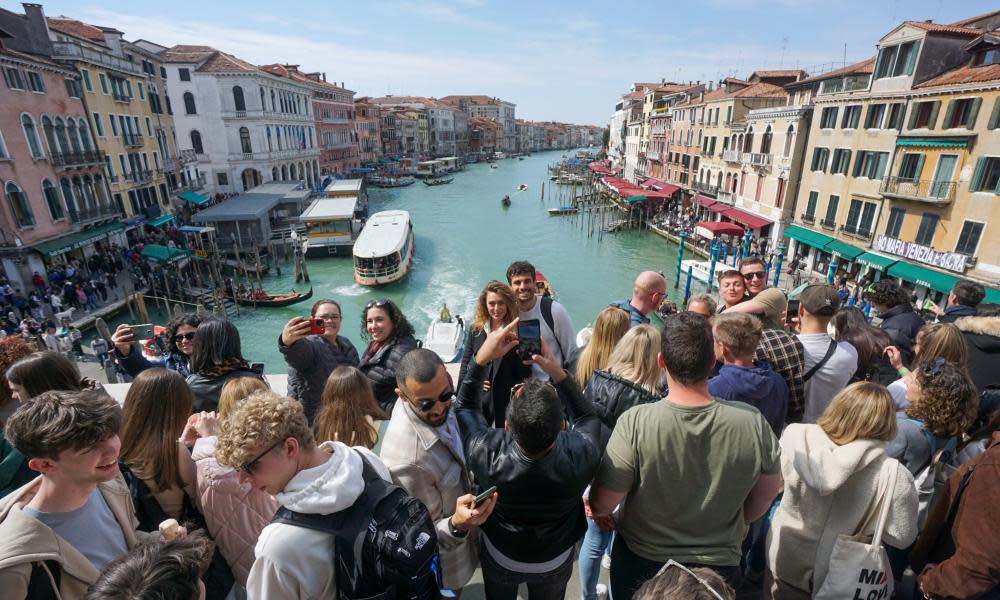Venice awaits Unesco heritage ruling as beds for tourists outnumber residents for first time

The number of beds available to tourists on Venice’s main island has surpassed the number of year-round residents for the first time, as a Unesco decision on the city’s future on the world heritage site list looms.
There are now 49,693 tourist beds across hotels and rented holiday homes, compared with 49,304 inhabitants.
Once the heart of a powerful maritime republic, Venice’s main island has lost more than 120,000 residents since the early 1950s, driven away by myriad issues but mainly a focus on mass tourism that has caused the city’s population to be dwarfed by the thousands of visitors who crowd its squares, bridges and narrow walkways each day.
Venessia.com, an activist group that for years has campaigned to preserve Venice’s heritage, has been keeping track of the population level in the historic centre, displaying the dwindling figure on an electronic ticker in the window of Morelli chemists since 2008.
The number of residents dipped below 50,000 for the first time last summer.
“We feel like foreigners in our own home, because when you walk along the streets we are in the minority,” said Matteo Secchi, who leads Venessia.com. “Every now and then you see a fellow Venetian and you salute them from afar, but other than that you are surrounded by tourists.”
Ocio, a residents’ group focused on housing issues in Venice, placed an electronic ticker in the window of the Marco Polo bookshop in April to display the growing number of beds available to tourists in the city.
“We never imagined that within a few months the number on the ticker would exceed that of the residents’ ticker,” the association said in a statement on its website.
A recommendation by the UN’s cultural agency to add Venice to the heritage danger list will be put to a meeting of Unesco’s world heritage committee, which got under way in the Saudi Arabian capital, Riyadh, on Sunday.
The agency said in July that Venice faced “irreversible” damage due to a litany of problems ranging from the effects of climate breakdown to mass tourism, while noting a “lack of significant progress” by Italy in addressing the issues.
The Ocio group said: “Although the [number of tourist beds] had already overtaken [residents] in some districts, ahead of the [Unesco] meeting we wanted to highlight how the constant opening of hotels and the lack of regulation of short-term rentals have progressively transformed the historic city into a tourist spot.”
Visitors to Venice returned in full force this summer after severe flooding in late 2019 and then the pandemic disrupted tourism. An average of 40,000 daytrippers poured into the city on peak days, prompting Venice’s local authority to announce it would enforce a long-mooted entrance ticket from next year.
Related: Venice to trial €5 ticketing system for day visitors from 2024
The €5 fee will apply only to those who visit the city for a day. The aim is to discourage daytrippers during peak periods as a way to preserve the “fragility” and “uniqueness of the city”, according to local authority leaders.
Simone Venturini, the councillor for tourism, said the measure would position Venice as a “trailblazer on the global level” and was not about making a profit but finding “a new balance between the rights of those who live, study or work in Venice, and those who visit the city”.
However, Secchi fears the initiative will turn Venice into a theme park rather a place where people want to live and work. “Venice needs to regulate the tourist flow, not charge an entrance fee,” he said.
The meeting of Unesco’s world heritage committee runs until 23 September, and it is unclear when a decision about Venice will be announced.
It is the second time within the space of a few years that the city, which was inscribed on the world heritage site list in 1987, has been threatened with the blacklist.
“We don’t need Unesco to tell us we’re at risk,” Secchi said. “We’ve known for decades. But maybe being put on the danger list will sprinkle a bit of pepper on to the authorities to do more.”

 Yahoo News
Yahoo News 
